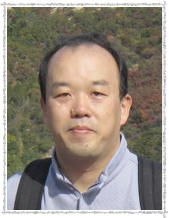

Functional materials chemistry, Physical organic chemistry, Solid state chemistry, X-Ray crystal structure analysis, Development of multifunctional molecular conductors exhibiting conductivities, magnetism and photofunctionalities, Development of new dye molecules for dye-sensitized solar cells
機能物質科学、物性有機化学、固体化学、X線構造解析、伝導性・磁性・光機能性を併せ持つ分子性伝導体の開発、色素増感太陽電池用新規色素分子の開発
機能物質科学、物性有機化学、固体化学、X線構造解析、伝導性・磁性・光機能性を併せ持つ分子性伝導体の開発、色素増感太陽電池用新規色素分子の開発

Received Ph.D. (1999) from Kyoto University.
1996 Research Associate at Institute for Molecular Science, Okazaki National Research Institutes
2003 Research Associate at Research Institute for Advanced Science and Technology, Osaka Prefecture University
2005 Research Associate at Department of Chemistry, Osaka Prefecture University
2006 Lecturer at Department of Chemistry, Osaka Prefecture University
2010 Associate Professor at Department of Chemistry, Osaka Prefecture University
2016 Associate Professor at Department of Chemistry, Osaka Prefecture University
Awards
2003 The Chemical Society of Japan Award for Young Chemists
1996 Research Associate at Institute for Molecular Science, Okazaki National Research Institutes
2003 Research Associate at Research Institute for Advanced Science and Technology, Osaka Prefecture University
2005 Research Associate at Department of Chemistry, Osaka Prefecture University
2006 Lecturer at Department of Chemistry, Osaka Prefecture University
2010 Associate Professor at Department of Chemistry, Osaka Prefecture University
2016 Associate Professor at Department of Chemistry, Osaka Prefecture University
Awards
2003 The Chemical Society of Japan Award for Young Chemists

My research topics are;
(1) The development of new functional molecular conductors which can exhibit cooperative phenomena between several functionalities such as conductivity, magnetism and photofunctionalities. For example, we have developed several magnetic conductors such as κ-(BETS)2FeBr4 and TTFVS(O) systems which realized antiferromagnetic superconductors, magnetic-field-induced superconductivity, antiferromagnetic metals, negative magnetoresistance effects and so on. We also developed photoinduced conductors using TTF (tetrathiafulvalene) derivatives containing a fluorescent part such as 2, 5-diphenyl-1, 3, 4-oxadiazole, fluorene, 1, 3-benzothiazole and BODIPY (4,4-difluoro-4-bora- 3a,4a-diaza-s-indacene) molecules. We have observed photoinduced conductivities and photoelectric conversion functionalities in both their crystals and thin films.
(2) The development of new dye molecules for dye-sensitized solar cells. We have synthesized new D-pi-A dye molecules and fabricated solar cell devices using new dyes and investigated their performances. Especially we have focused on the development of new anchoring groups to be attached on titanium oxide particles.
(1) The development of new functional molecular conductors which can exhibit cooperative phenomena between several functionalities such as conductivity, magnetism and photofunctionalities. For example, we have developed several magnetic conductors such as κ-(BETS)2FeBr4 and TTFVS(O) systems which realized antiferromagnetic superconductors, magnetic-field-induced superconductivity, antiferromagnetic metals, negative magnetoresistance effects and so on. We also developed photoinduced conductors using TTF (tetrathiafulvalene) derivatives containing a fluorescent part such as 2, 5-diphenyl-1, 3, 4-oxadiazole, fluorene, 1, 3-benzothiazole and BODIPY (4,4-difluoro-4-bora- 3a,4a-diaza-s-indacene) molecules. We have observed photoinduced conductivities and photoelectric conversion functionalities in both their crystals and thin films.
(2) The development of new dye molecules for dye-sensitized solar cells. We have synthesized new D-pi-A dye molecules and fabricated solar cell devices using new dyes and investigated their performances. Especially we have focused on the development of new anchoring groups to be attached on titanium oxide particles.

- A novel antiferromagnetic organic superconductor kappa-(BETS)2FeBr4 [where BETS = bis(ethylenedithio)tetraselenafulvalene], H. Fujiwara, E. Fujiwara, Y. Nakazawa, B. Z. Narymbetov, K. Kato, H. Kobayashi, A. Kobayashi, M. Tokumoto, P. Cassoux, J. Am. Chem. Soc., 123, 306-314 (2001)
- An indication of magnetic-field-induced superconductivity in a bifunctional layered organic conductor, kappa-(BETS)2FeBr4, H. Fujiwara, H. Kobayashi, E. Fujiwara, A. Kobayashi, J. Am. Chem. Soc., 124, 6816-6817 (2002)
- Synthesis, Structures and Physical Properties of a New Organic Conductor Based on a pi-Extended Donor Containing a Stable PROXYL Radical, H. Fujiwara, H.-J. Lee, H.-B. Cui, H. Kobayashi, E. Fujiwara,A. Kobayashi, Adv. Mater., 16, 1765-1769 (2004).
- Development of an Antiferromagnetic Organic Superconductor kappa-(BETS)2FeBr4, H. Fujiwara, H. Kobayashi, Bull. Chem. Soc. Jpn., 78, 1181-1196 (2005).
- Molecular Conductors Based on peri-Ditellurium Bridged Donors, 2,3-DMTTeA and TMTTeN, E. Fujiwara, H. Fujiwara, B. Zh. Narymbetov, H. Kobayashi, M. Nakata, H. Torii, A. Kobayashi, K. Takimiya, T. Otsubo, F. Ogura, Eur. J. Inorg. Chem., 3435-3449 (2005).
- Stable Metallic Behavior and Antiferromagnetic Ordering of Fe(III) d Spins in (EDO-TTFVO)2・FeCl4, H. Fujiwara, K. Wada, T. Hiraoka, T. Hayashi, T. Sugimoto, H. Nakazumi, K. Yokogawa, M. Teramura, S. Yasuzuka, K. Murata, T. Mori, J. Am. Chem. Soc., 127, 14166-14167 (2005).
- A Metallic (EDT-DSDTFVSDS)2・FeBr4 Salt: Antiferromagnetic Ordering of d Spins of FeBr4- Ions and Anomalous Magnetoresistance due to Preferential pi-d Interaction, T. Hayashi, X.-W. Xiao, H. Fujiwara, T. Sugimoto, H. Nakazumi, S. Noguchi, T. Fujimoto, S. Yasuzuka, H. Yoshino, K. Murata, T. Mori, H. Aruga-Katori, J. Am. Chem. Soc., 128, 11746-11747 (2006).
- Magnetoresistance Effects Evidencing the pi-d Interaction in Metallic Organic Conductors, (EDT-DSDTFVO)2・MX4 (M = Fe, Ga; X = Cl, Br), H. Fujiwara, T. Hayashi, T. Sugimoto, H. Nakazumi, S. Noguchi, L. Li, K. Yokogawa, S. Yasuzuka, K. Murata, T. Mori, Inorg. Chem., 45, 5712-5714 (2006).
- Synthesis, structure and photoelectrochemical properties of new tetrathiafulvalene-diphenyl-1,3,4-oxadiazole dyads, H. Fujiwara, Y. Sugishima, K. Tsujimoto, Tetrahedron Lett., 49, 7200–7203 (2008).
- New aspects of π–d interactions in magnetic molecular conductors, T. Sugimoto, H. Fujiwara, S. Noguchi, K. Murata, Science and Technology of Advanced Materials, 10, 024302 (2009).
- CuII and CuI Coordination Complexes Involving Two Tetrathiafulvalene-1,3-benzothiazole Hybrid Ligands and their Radical Cation Salts, S. Yokota, K. Tsujimoto, S. Hayashi, F. Pointillart, L. Ouahab, H. Fujiwara, Inorg. Chem., 52, 6543-6550 (2013)
- TTF-fluorene dyads and their M(CN)2– (M = Ag, Au) salts designed for photoresponsive conducting materials, K. Tsujimoto, R. Ogasawara, Y. Kishi, H. Fujiwara, New J. Chem., 38, 406-418 (2014)
- Photofunctional Conductors Based on TTF-BODIPY Dyads Bearing p-Phenylene and p-Phenylenevinylene Spacers, K. Tsujimoto, R. Ogasawara, T. Nakagawa, H. Fujiwara, Eur. J. Inorg. Chem., 3960-3971 (2014)



























